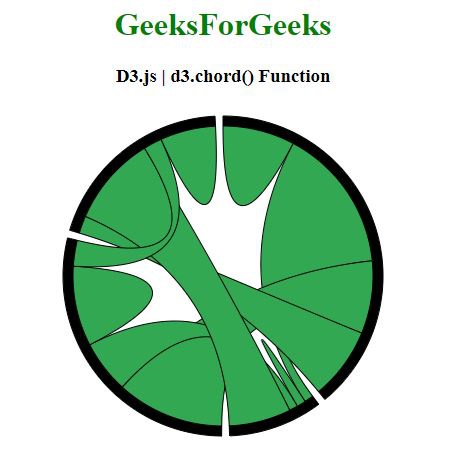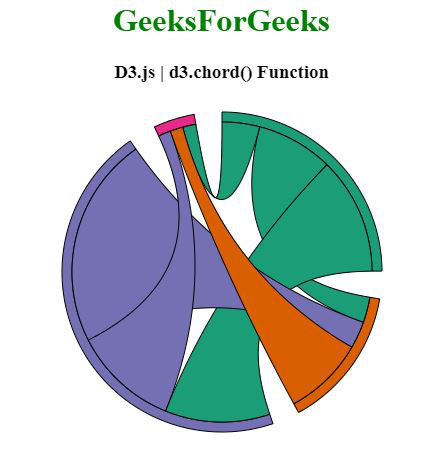D3.js中的d3.chord()函数用于返回具有默认设置的构造的新和弦布局。
用法:
d3.chord()
参数:该函数不接受任何参数。
返回值:此函数返回构造的新和弦布局。
以下程序说明了D3.js中的d3.chord()函数:
范例1:
HTML
<!DOCTYPE html>
<html>
<head>
<script src=
"https://d3js.org/d3.v4.min.js">
</script>
</head>
<body>
<center>
<h1 style="color:green;">GeeksForGeeks</h1>
<h3>D3.js | d3.chord() Function</h3>
<div id="GFG"></div>
<script>
// Create the svg area
var svg = d3.select("#GFG")
.append("svg")
.attr("width", 340)
.attr("height", 340)
.append("g")
.attr("transform", "translate(170,170)")
// Create input data
var data = [[8010, 16145, 8090, 8045],
[1013, 990, 940, 6907],
[11975, 5871, 8916, 2868],
[1951, 10048, 2060, 6171]];
// Give this matrix to d3.chord()
var chords = d3.chord()
.padAngle(0.05)
(data)
// Add the groups on the inner part
// of the circle
svg.datum(chords)
.append("g")
.selectAll("g")
.data(function (d) { return d.groups; })
.enter()
.append("g")
.append("path")
.style("fill", "black")
.style("stroke", "black")
.attr("d", d3.arc()
.innerRadius(150)
.outerRadius(160)
)
// Add the links between groups
svg.datum(chords)
.append("g")
.selectAll("path")
.data(function (d) { return d; })
.enter()
.append("path")
.attr("d", d3.ribbon()
.radius(150)
)
.style("fill", "#32a852")
.style("stroke", "black");
</script>
</center>
</body>
</html>输出:

范例2:
HTML
<!DOCTYPE html>
<html>
<head>
<script src=
"https://d3js.org/d3.v4.min.js">
</script>
<script src=
"https://d3js.org/d3-color.v1.min.js">
</script>
<script src=
"https://d3js.org/d3-interpolate.v1.min.js">
</script>
<script src=
"https://d3js.org/d3-scale-chromatic.v1.min.js">
</script>
</head>
<body>
<center>
<h1 style="color:green;">GeeksForGeeks</h1>
<h3>D3.js | d3.chord() Function</h3>
<div id="GFG"></div>
<script>
// Create the svg area
var svg = d3.select("#GFG")
.append("svg")
.attr("width", 340)
.attr("height", 340)
.append("g")
.attr("transform", "translate(170,170)")
// Create input data
var data = [[0, 5871, 8916, 2868],
[1951, 0, 2060, 6171],
[8010, 16145, 0, 8045],
[1013, 990, 940, 0]];
// 4 groups, so create a vector of 4 colors
var colors =
[d3.schemeDark2[0], d3.schemeDark2[1],
d3.schemeDark2[2], d3.schemeDark2[3]];
// Give this matrix to d3.chord()
var chords = d3.chord()
.padAngle(0.175)
.sortSubgroups(d3.ascending)
(data)
// Add the groups on the inner part
// of the circle
svg.datum(chords)
.append("g")
.selectAll("g")
.data(function (d) { return d.groups; })
.enter()
.append("g")
.append("path")
.style("fill", function (d, i) {
return colors[i]
})
.style("stroke", "black")
.attr("d", d3.arc()
.innerRadius(150)
.outerRadius(160)
)
// Add the links between groups
svg.datum(chords)
.append("g")
.selectAll("path")
.data(function (d) { return d; })
.enter()
.append("path")
.attr("d", d3.ribbon()
.radius(150)
)
.style("fill", function (d) {
return (colors[d.source.index])
})
.style("stroke", "black");
</script>
</center>
</body>
</html>输出:

相关用法
- d3.js chord.sortChords()用法及代码示例
- d3.js chord.padAngle()用法及代码示例
- d3.js chord.sortGroups()用法及代码示例
- d3.js chord.sortSubgroups()用法及代码示例
- d3.js d3.rgb()用法及代码示例
- PHP pos()用法及代码示例
- PHP key()用法及代码示例
- d3.js d3.lab()用法及代码示例
- d3.js d3.hcl()用法及代码示例
- PHP max( )用法及代码示例
- d3.js zip()用法及代码示例
- PHP min( )用法及代码示例
- PHP pi( )用法及代码示例
- CSS var()用法及代码示例
- PHP pow( )用法及代码示例
注:本文由纯净天空筛选整理自SHUBHAMSINGH10大神的英文原创作品 D3.js chord() Function。非经特殊声明,原始代码版权归原作者所有,本译文未经允许或授权,请勿转载或复制。
